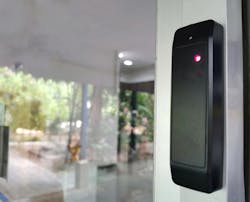Wi-Fi HaLow standard a new modality for wireless access control
Secured access controls are an important component to building automation systems as they ensure the security of a resource or building, its occupants and its contents.
For access control systems to be successful, the security system architect needs to consider obvious points of entry, anticipated threats, and the ever-shifting credentials for the users inside and outside of the defined space. Multiple types of hardware devices (locks, switches, sensors, keypads, readers, cameras, gates) need to be tied together with a suitable network to provide real-time status and control of the system. An integrated security system, whether running on a PC on-site or in a cloud-based remote monitoring station, will benefit from using Internet Protocol (IP) based networks that tie all the components together.
Whether the scale of the system is a single smart door lock for a home or hundreds of doors in a large hotel or office, the complexity and cost of the project could both increase.
Now, a robust wireless technology will soon deliver the flexibility to aggregate these various networks under one industry standard, while at the same time reduce overall cost and system complexities.
Low Power and More Range Equals Reduced Security Network Costs
Developed by the Wi-Fi Alliance with a certification program expected to be available in 2021, IEEE 802.11ah, or more commonly known as “Wi-Fi HaLow,” is a low-power, long-range Wi-Fi standard that provides 10 times the range, 100 times the area and 1,000 times the volume of traditional Wi-Fi – ideal for an access control system at a large enterprise with multiple cameras, locks, doors, etc.
While conventional Wi-Fi is the most ubiquitous wireless communications protocol in use today, the rapid growth of the IoT has forced a rethinking of Wi-Fi, revealed technological gaps and what role it needs to play in an all-encompassing connected world. Wi-Fi HaLow can be used in both indoor and outdoor applications where standard Wi-Fi cannot, such as battery-operated surveillance systems, wireless cameras, support for real-time video, and doorbells. A single Wi-Fi HaLow access point (AP) can connect to thousands of devices, bypassing complex, bandwidth-limited and less reliable mesh architecture. This results in simplifying the installation and reducing total cost of ownership.
For example, a decision to unlock a door might require confirming a person’s identity, validating the credentials of the security profile, and assessing the current situation in which the person desires to access. This demands low-latency, session-oriented connections of multiple inputs, outputs and intelligent systems. Wi-Fi HaLow’s high data rate, long distance reach, energy efficiency and security features support the growing network needs of locks, readers, gates, cameras, sensors and as-yet undefined security devices in an integrated system.
Strong Security at Your Front Door
Many residential smart locks available today were previously designed with a priority focus on low energy consumption at the expense of suffering very low data rates for their wireless communications technologies, such as Bluetooth, Zigbee, or proprietary radio protocols like Z-Wave. To reach an internet connection to enable remote control of the lock from a smart phone application, their proprietary gateways to the IP network are required at additional cost. The path to this gateway might require using a congested mesh of other like devices with very low data throughput and high latency. The prioritization of low energy consumption has constrained designers to use these technologies at the expense of reduced security and higher costs. Traditional Wi-Fi was rarely considered, due to its relatively high energy consumption and short reach.
With Wi-Fi HaLow, several advantages can be applied to smart locks solutions. Wi-Fi HaLow is an IPv6-ready standard and can connect directly to a whole home Wi-Fi HaLow router. The narrow-band, sub-1 GHz radio signals travel much farther and penetrate walls more effectively than 2.4 GHz solutions such as Bluetooth and Zigbee, without the need for additional gateways or complex meshes. WPA3 security ensures all control signals are encrypted. The data rates of 10s of Mbps provide plenty of headroom for fast firmware updates in the event that new threats are detected. This greatly simplifies the connection to cloud-based home automation applications, without the burden of proprietary infrastructure for the home owner or lock manufacturer.
Simplifying the Enterprise Access Control System Architecture
In large-scale commercial buildings, devices in the security network commonly include electronic strikes, magnetic plates, and hybrid smart locks. Other components in this network include external keypads or RFID card scanners outside each door, plus egress triggers on the inside of each door such as PIR motion detectors or request-to-exit (REX) buttons.
The typical installation requires the security agent’s PC to connect to a control station, which uses a network of wires to control the low voltage power transformers used to energize the locks or change their states. Another method might use Power-over-Ethernet (PoE) to offer control signals and power to a gateway controller device, up to a maximum distance of 100 meters away. Some systems use a hybrid distribution network of PoE and RS-485 protocol to reach proprietary access points nearby groups of rooms that each have wireless smart locks in the doors.
Wi-Fi HaLow simplifies this network of devices by not only lowering the costs of the security network infrastructure, but also the cost and time of installation, and reduces maintenance costs of the system from battery changes and firmware updates. The standard provides a simplified star-oriented architecture for connecting a high density of sensors and lock controllers and can incorporate directly into battery-operated door lock sets, without the need for intermediary sub gateways or proprietary controllers. The network can be as simple as a Wi-Fi HaLow AP connected to a single PoE cable on each floor. Each lock is then capable of operating as a premise-based or cloud-based device.
Wi-Fi HaLow can also be used as a backhaul network to replace low-speed cabling between the backbone network and region of devices. There is a significant cost of materials and labor to install, move or change RS-485 or PoE networks to add features. If the system architect needs to add video or other multi-factor authentication to a wireless door lock, Wi-Fi HaLow has the capacity to handle the demands.
The benefits of Wi-Fi HaLow can also be extended outside to control peripheral access points at the edge of the property and serve multiple sensor devices, such as motion detectors and proximity sensors for early warning of approaching threats. Other long-range wireless networks incorporate extremely low data rates, and only for very small packets of data.
Wi-Fi HaLow solves these issues with a single simplified standard. For example, a single AP can support up to 8,191 devices, more than the number of rooms in the world’s largest hotels. The sub-1 GHz, narrow-band RF signals penetrate through walls, doors, ceilings and floors. Signals reach farther, with ranges that can accommodate devices that would normally require wired signal connections
Powering the Future of Access Control Security
Whether a home or an office complex, structure automation technology must evolve to meet demands for better security, energy efficiency, and tenant convenience.
The network congestion, distance limitations and higher power usage of conventional Wi-Fi, along with the limited number of devices that can be connected to a single wireless AP are no longer viable in a connected world of smart devices where security is paramount. Such limitations impede new IoT-centric business models that are emerging across industries, which require greater capacity, range and battery operation while minimizing deployment costs and timelines
With Wi-Fi HaLow wireless technology, the concept of ripping out old wires and putting in new wires may be a thing of the past.
About the Author:
Vahid Manian is chief operating officer of Morse Micro (www.morsemicro.com), a developer of advanced wireless technologies. His 35-plus years of semiconductor contributions include Vice Chairman of Board of Directors for Global Semiconductor Alliance (GSA) and a founding member of Broadcom’s operations organization, where he grew the company from pre-revenue to nearly $6 billion, shipping over 1 billion devices annually. Prior to joining Morse Micro, he was COO of Ethertronics Corporation.
About the Author

Vahid Manian
Chief Operating Officer, Morse Micro
Vahid Manian is chief operating officer of Morse Micro (www.morsemicro.com), a developer of advanced wireless technologies. His 35-plus years of semiconductor contributions include Vice Chairman of Board of Directors for Global Semiconductor Alliance (GSA) and a founding member of Broadcom’s operations organization, where he grew the company from pre-revenue to nearly $6 billion, shipping over 1 billion devices annually. Prior to joining Morse Micro, he was COO of Ethertronics Corporation.
